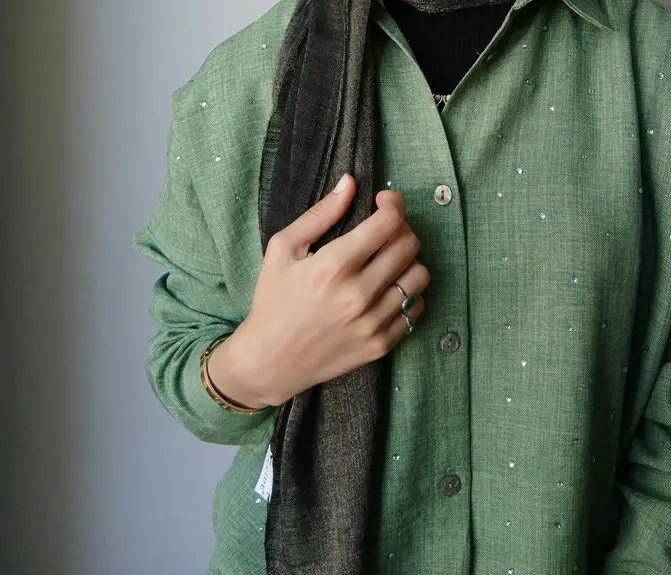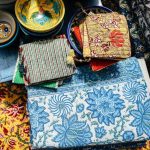You’ll love how Ikat fabric brings timeless elegance and vibrant culture into your wardrobe or home. Its unique resist-dyeing technique produces bold, blurred patterns that showcase skilled craftsmanship from around the world. Whether in fashion or decor, Ikat adds a rich, artistic touch that never feels outdated. Plus, it’s rooted in centuries of tradition, yet always evolving with new sustainable trends. Keep exploring to discover how Ikat’s story and style continue to inspire.
Table of Contents
Key Takeaways
- Ikat fabric features timeless, bold geometric patterns and vibrant or subtle color palettes that maintain cultural significance and visual appeal.
- The traditional resist dyeing technique creates unique blurred patterns, making each Ikat piece authentic and artistically valued.
- Ikat’s rich cultural heritage spans multiple regions, reflecting stories, rituals, and identities that resonate across generations.
- Modern fashion and home decor embrace Ikat for its striking designs, pairing it with simple elements to create stylish, versatile looks.
- Sustainable production trends, including organic fibers and eco-friendly dyes, ensure Ikat’s relevance and ethical appeal in contemporary markets.
The Origins and History of Ikat Fabric
Although its exact origins remain debated, ikat fabric has captivated cultures around the world for centuries.
When you explore ikat’s history, you’ll find it stretching across Asia, Central and South America, and parts of Africa. This fabric’s appeal lies in its distinctive patterns, created long before modern printing techniques existed.
You’ll notice that ikat has deep cultural significance, often linked to rituals, status, and identity in many societies. Whether in Indonesian villages or Mexican communities, ikat carries stories and traditions passed down through generations.
As you wear or admire ikat fabric, you connect with a rich heritage that’s both ancient and alive today, reflecting the artistry and ingenuity of countless cultures worldwide.
The Unique Dyeing Technique Behind Ikat
You’ll notice Ikat’s unique look comes from a resist dyeing process where threads are tied and dyed before weaving.
Getting the patterns to align perfectly takes skill and patience.
Different cultures have put their own spin on this technique, creating stunning variations worldwide.
Resist Dyeing Process
When you look closely at Ikat fabric, you’ll notice its distinctive blurred patterns, a result of the resist dyeing process that sets it apart from other textiles. This technique involves binding sections of yarn tightly before dyeing, preventing certain areas from absorbing color. After dyeing, the bindings are removed, revealing intricate, soft-edged designs. You’ll appreciate how this method creates unique patterns with a characteristic fuzziness, unlike sharp prints.
| Step | Description |
|---|---|
| Binding | Tie yarn sections tightly to resist dye penetration |
| Dyeing | Submerge yarns in dye baths, coloring exposed areas |
| Unbinding & Weaving | Remove ties and weave yarns into fabric, revealing patterns |
This resist dyeing process guarantees every Ikat piece has its own charm and authenticity.
Pattern Alignment Challenges
Because the pattern forms on yarn before weaving, aligning the designs perfectly on Ikat fabric presents a real challenge. You have to carefully position each dyed yarn so that the intended motif emerges clearly once woven.
Even a slight misalignment can blur the pattern or create unwanted distortions. As you weave, maintaining consistent tension and spacing is essential to keep the design intact.
Since the dyeing involves resist techniques applied to bundles of threads, variations in stretch or shrinkage add complexity. You’ll find that achieving flawless symmetry demands patience and skill, as the interplay between dyed yarns and weaving determines the final look.
This delicate balance makes Ikat fabric unique and highly valued for its handcrafted charm and imperfect beauty.
Cultural Origins and Variations
Although Ikat fabric is admired worldwide, its origins trace back to distinct cultures that each developed unique dyeing techniques.
When you explore Ikat, you’ll notice variations that reflect these cultural roots. Here’s what you should know:
- Indonesian Ikat uses intricate patterns with a double ikat method, tying both warp and weft threads.
- Indian Ikat from Odisha and Gujarat often showcases bold, geometric designs created through warp ikat.
- Central Asian Ikat, especially Uzbek, features vibrant colors and floral motifs through weft ikat.
- Japanese Kasuri employs a subtle, blurred effect with delicate patterns, emphasizing simplicity.
Cultural Significance of Ikat Around the World
You’ll find Ikat traditions thriving across many cultures, each with its own unique twist.
The designs often carry deep symbolism that tells stories or signifies status.
Exploring these regional variations will help you appreciate the rich cultural meaning behind every pattern.
Ikat Traditions Globally
Across at least five continents, ikat traditions have woven themselves into the cultural fabric of many societies, each with its unique techniques and meanings.
When you explore ikat globally, you’ll find diverse styles shaped by local customs and materials. Here’s a quick look at key regional variations you should know:
- Indonesia’s ikat uses intricate double ikat techniques, renowned for precision and vibrant colors.
- India’s Patola ikat from Gujarat features complex geometric patterns, often reserved for special occasions.
- Central Asian ikat, such as Uzbek suzani, highlights bold, large-scale motifs with silk threads.
- Latin American ikat, especially from Guatemala and Mexico, blends indigenous symbolism with vivid color palettes.
Understanding these traditions helps you appreciate ikat’s artistic depth and cultural richness worldwide.
Symbolism in Ikat Designs
Many ikat patterns carry deep symbolic meanings that reflect the beliefs, values, and histories of their communities. When you wear or use ikat fabric, you’re embracing stories woven into every thread.
For example, in some cultures, specific motifs represent fertility, protection, or spiritual guidance. You’ll find that colors also hold significance—red might symbolize courage, while white conveys purity.
These designs aren’t just decorative; they communicate identity and status, connecting you to generations past. Understanding the symbolism enhances your appreciation of ikat, turning it from mere fabric into a meaningful expression of culture.
Regional Ikat Variations
Although ikat shares a common technique of resist-dyeing threads before weaving, its styles and meanings vary widely depending on the region.
When you explore ikat globally, you’ll notice distinct characteristics that reflect local culture and tradition.
Here are four key regional ikat variations you should know:
- Indonesian Ikat – Known for intricate patterns symbolizing social status and mythology.
- Indian Ikat – Features vibrant colors and geometric designs often used in traditional ceremonies.
- Japanese Kasuri – Displays subtle, blurred edges with a minimalist aesthetic.
- Central Asian Ikat – Bold, symmetrical motifs representing nature and tribal identity.
Distinctive Patterns and Color Palettes in Ikat Designs
When you explore Ikat designs, you’ll notice how their patterns and color palettes immediately stand out. These fabrics showcase bold geometric shapes, zigzags, and diamond motifs, often combined with organic, flowing lines. Their colors range from vibrant reds and blues to subtle earth tones, reflecting cultural significance and natural dyes.
Here’s a quick glance at distinctive Ikat patterns and colors:
| Pattern Type | Common Colors | Cultural Influence |
|---|---|---|
| Geometric Shapes | Red, Black, White | Central Asia |
| Organic Motifs | Earthy Browns, Greens | Southeast Asia |
| Zigzag Patterns | Blue, Turquoise | Indonesia |
| Diamond Motifs | Yellow, Orange | South America |
You’ll find these elements create timeless, eye-catching designs that keep Ikat relevant.
How Ikat Fabric Is Made: From Thread to Textile
The striking patterns and colors of Ikat fabric come to life through a meticulous process that starts long before weaving begins.
Ikat’s vibrant patterns emerge from a careful process that begins well before the weaving itself.
You’ll first prepare the threads, carefully selecting cotton or silk. Next, you tie sections of these threads tightly with a resist material.
Here’s how you make Ikat fabric:
- Resist Tying: Bind thread sections to resist dye penetration.
- Dyeing: Submerge the tied threads in dye baths to create patterns.
- Untying: Remove bindings to reveal the dyed and undyed areas.
- Weaving: Align the threads precisely on the loom to reproduce the intended design.
Incorporating Ikat Into Modern Fashion
Many designers have embraced Ikat fabric for its bold patterns and rich cultural heritage, making it a standout choice in contemporary wardrobes. You can easily incorporate Ikat into your fashion by pairing it with simple, solid pieces to let the fabric shine. Whether it’s a dress, jacket, or accessories, Ikat adds vibrant texture and cultural flair. Here’s a quick guide to help you style Ikat in modern fashion:
| Item | Styling Tip | Occasion |
|---|---|---|
| Ikat Dress | Keep accessories minimal | Casual to semi-formal |
| Ikat Jacket | Pair with neutral tones | Office or outings |
| Ikat Scarf | Use as a statement piece | Everyday wear |
| Ikat Pants | Balance with plain tops | Casual |
| Ikat Bag | Match with denim | Weekend or travel |
Using Ikat for Home Decor and Interior Design
Although Ikat is often celebrated in fashion, you can also bring its vibrant patterns and cultural richness into your home decor.
Using Ikat fabric adds a unique touch that instantly livens up any space. Here’s how you can incorporate it effectively:
- Throw Pillows: Add pops of color and texture to your sofa or bed.
- Curtains: Frame your windows with eye-catching, patterned drapes.
- Upholstery: Reupholster chairs or ottomans to create statement furniture pieces.
- Wall Hangings: Use Ikat fabric as tapestry art to introduce cultural flair.
Caring for and Maintaining Ikat Fabric
Caring for Ikat fabric requires gentle handling to preserve its vibrant patterns and delicate fibers. Always hand wash with cold water and mild detergent to avoid color bleeding. Avoid wringing or twisting; instead, gently press out excess water and air dry away from direct sunlight. Iron on a low setting while the fabric is slightly damp to maintain texture.
| Care Step | Why It Matters | Pro Tip |
|---|---|---|
| Hand wash only | Prevents damage and fading | Use cold water and mild soap |
| Air dry | Preserves fabric integrity | Dry in shade, avoid sunlight |
| Low heat iron | Keeps fabric smooth | Iron while damp, inside out |
Following these tips helps your Ikat fabric stay beautiful for years.
The Future of Ikat: Innovation and Sustainability Trends
As you explore the world of Ikat fabric, you’ll notice that innovation and sustainability are reshaping its future.
You’ll find artisans and designers embracing eco-friendly dyes and natural fibers, reducing environmental impact without sacrificing quality. Technology is enhancing traditional techniques, making production more efficient and accessible.
To stay ahead, consider these trends:
Embrace sustainability and innovation to keep Ikat fabric craftsmanship vibrant and ethically forward.
- Use of organic cotton and bamboo fibers for sustainability.
- Adoption of low-impact, plant-based dyes preserving vibrant colors.
- Integration of digital tools to streamline pattern design.
- Support for fair-trade practices ensuring ethical craftsmanship.
Frequently Asked Questions
Can Ikat Fabric Be Machine Washed Without Damage?
You shouldn’t machine wash ikat fabric as it can damage the fibers and fade the colors. Instead, hand wash it gently in cold water with mild detergent to keep it looking vibrant and intact longer.
What Types of Clothing Suit Ikat Patterns Best?
You’ll find ikat patterns dance beautifully on flowing dresses and cozy scarves, adding flair to casual shirts and skirts. Don’t hesitate to let these vibrant, blurred designs steal the spotlight in your wardrobe’s spotlight moments.
Is Ikat Fabric Hypoallergenic or Suitable for Sensitive Skin?
You’ll find that ikat fabric’s hypoallergenic qualities depend on the fibers used. Natural fibers like cotton or silk suit sensitive skin well, but synthetic blends might cause irritation, so always check the material before wearing.
Where Can I Buy Authentic Handmade Ikat Fabric?
Imagine vibrant threads woven by skilled hands. You can buy authentic handmade ikat fabric from artisan markets, specialty boutiques, or online platforms like Etsy, where creators share their unique, carefully crafted textile masterpieces directly with you.
How Long Does It Take to Create a Single Ikat Textile?
It can take you anywhere from several days to weeks to create a single ikat textile. The process involves meticulous dyeing and weaving, so patience is key if you want authentic, high-quality fabric.
- Does Chiffon Fabric Stink - July 15, 2025
- Does Chiffon Fabric Affect the Economy - July 15, 2025
- Does Cotton Fabric Have a Nap - July 15, 2025







